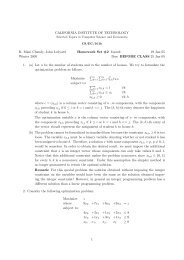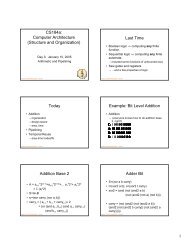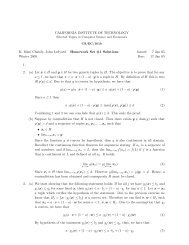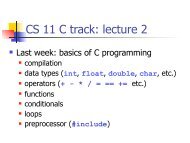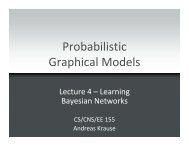1 Differential Forms - Caltech
1 Differential Forms - Caltech
1 Differential Forms - Caltech
You also want an ePaper? Increase the reach of your titles
YUMPU automatically turns print PDFs into web optimized ePapers that Google loves.
nFaces = size( d1, 1 );<br />
for i = 1:nFaces<br />
end<br />
% initialize an empty list of vertex indices<br />
ind = [];<br />
for j = find( d1( i, : )) % iterate over this face’s edges<br />
for k = find( d0( j, : )) % iterate over this edge’s vertices<br />
end<br />
end<br />
% append the current vertex index to the list<br />
ind = [ ind, k ];<br />
% eliminate redundant vertex indices from the list<br />
I = unique( I );<br />
The find command returns a list of the indices of all non-zero entries in a given vector. So for instance,<br />
since the ith row of d 1 corresponds to the ith face in the mesh, we can run find on this row to get the indices<br />
of all the incident edges. The unique command removes any element of a list that appears more than once.<br />
In our example above every vertex is found in two edges of a given face, so we remove redundant indices with<br />
unique. This type of mesh traversal will be useful in later coding exercises.<br />
2.3.2 Smooth Exterior Derivative on 0-forms<br />
For some of the above exercises it will be necessary to compute the exterior derivative of smooth 0-forms in<br />
coordinates. Such a computation is actually quite simple: for instance, given a (smooth) 0-form f : R 2 → R, its<br />
exterior derivative is given by<br />
d f = ∂ f<br />
∂x dx + ∂ f<br />
∂y dy.<br />
The forms dx and dy can be thought of as standard bases for the (dual) plane. [ It is therefore ] sometimes<br />
∂ f /∂x<br />
convenient to think of d f as being merely the transpose of the column vector ∇ f = . Also note that d<br />
∂ f /∂y<br />
is a linear operator since ∂ ∂x and ∂ ∂y<br />
are both linear operators.<br />
Exercise 8. Compute (in coordinates) the smooth exterior derivative of the 0-form α : R 3 → R given by<br />
α = y cos z + 4 sin x.<br />
8



